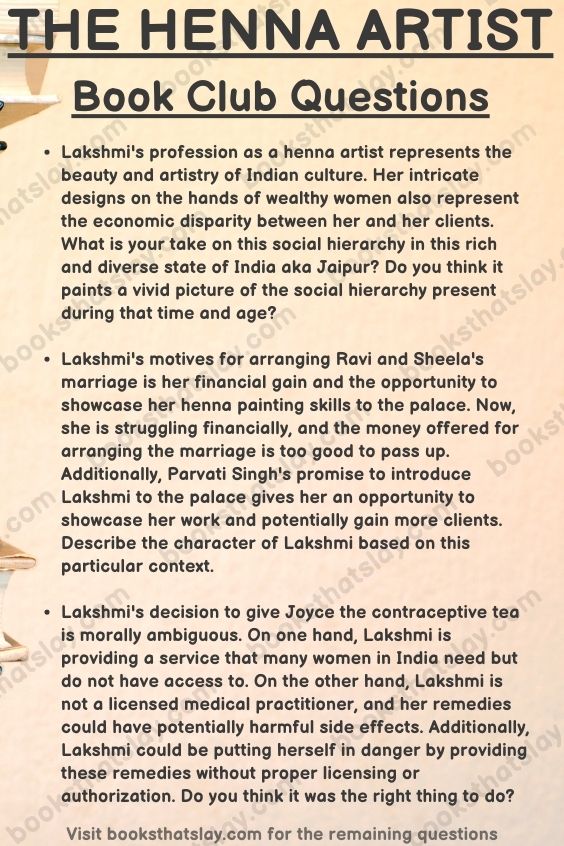12 The Henna Artist Book Club Questions
Immerse yourself during the time of 1950s Jaipur where Lakshmi, a spirited young woman, escapes an abusive marriage to find freedom and purpose as a henna artist.
As she navigates the complexities of tradition and modernity, her carefully constructed world is threatened by a haunting past.
Alka Joshi’s debut novel is a captivating exploration of resilience, identity, and the enduring power of the human spirit.
Join us as we delve into this enchanting story, discussing themes of courage, sisterhood, and the challenges faced by women in a bygone era.

The Henna Artist Book Club Questions
- Lakshmi’s profession as a henna artist represents the beauty and artistry of Indian culture. Her intricate designs on the hands of wealthy women also represent the economic disparity between her and her clients.
What is your take on this social hierarchy in this rich and diverse state of India a.k.a Jaipur? Do you think it paints a vivid picture of the social hierarchy present during that time and age?
- Lakshmi’s motives for arranging Ravi and Sheela’s marriage is her financial gain and the opportunity to showcase her henna painting skills to the palace. Now, she is struggling financially, and the money offered for arranging the marriage is too good to pass up. Additionally, Parvati Singh’s promise to introduce Lakshmi to the palace gives her an opportunity to showcase her work and potentially gain more clients.
Describe the character of Lakshmi based on this particular context. Which traits of her did you like the most?
- Lakshmi’s decision to give Joyce the contraceptive tea is morally ambiguous. On one hand, Lakshmi is providing a service that many women in India need but do not have access to. On the other hand, Lakshmi is not a licensed medical practitioner, and her remedies could have potentially harmful side effects. Additionally, Lakshmi could be putting herself in danger by providing these remedies without proper licensing or authorization.
Do you think it was the right thing to do? If you were in place of her, what would you have done instead?
- Henna plays a significant cultural role in Lakshmi’s life and the story as a whole. Henna is a traditional art form in India and is often used for celebrations and ceremonies. Lakshmi’s henna painting skills are an important aspect of her identity and her livelihood, as she uses her skills to make money and gain social status.
Do you think this henna signifies a much bigger role as compared to just a reddish-brown dye? What can it represent, according to you?
- Lakshmi tries to persuade Radha to take contraceptive tea, but Radha refuses, emphasizing her right to make her own decisions. Meanwhile, Kanta blames herself for Radha’s pregnancy, highlighting how society puts the burden of responsibility on women instead of the situation surrounding it. Now, the men are not held accountable for their actions, with Ravi denying paternity and Hari being oblivious to the situation.
What is your take on the way Radha’s pregnancy was handled in the story?
- The pressure on Radha to give up her child for adoption reflects the stigma attached to single motherhood. It also highlights the importance of family and community support in raising children. I personally think this sheds ample light on the societal attitudes toward children born out of wedlock.
What’s your take on it? Also, do you think this adoption process and the role of the medical establishment in it raises questions about the ethical issues surrounding medical professionals when it comes to making such decisions?
- The novel addresses issues of class and privilege by portraying the stark differences in the lives of the wealthy and the poor. Lakshmi’s struggle to make ends meet and provide for her family is contrasted with the opulence and extravagance of the royal family. The characters from different social classes interact, and the story highlights the disparities in access to education, healthcare, and opportunities. The novel also highlights the corrupt practices of the wealthy, who use their power and influence to exploit the poor.
Discuss.
- The setting of post-independence India provides a backdrop for the characters in the novel to struggle with defining their own identities in a changing world. The characters’ experiences reflect the larger societal changes occurring in India during this time, including the shift from rural to urban living and the clash between traditional values and modernization.
Why do you think Joshi chose this particular time frame for the novel? Was it intentional because if this novel was set in the modern time frame, most issues mentioned would have been solved in today’s age?
- The relationship between Lakshmi and Radha evolves from one of estrangement and unfamiliarity to one of sisterhood and support. Lakshmi initially resents Radha’s arrival, feeling burdened by the responsibility of caring for her younger sister. However, as the novel progresses, Lakshmi begins to see similarities between herself and Radha and becomes more protective of her sister. Radha, in turn, begins to understand and appreciate Lakshmi’s choices and begins to assert her own independence.
What’s your take on such an amazing sense of sisterhood?
- The novel addresses the themes of cultural clash and cross-cultural understanding through its depiction of the clash between traditional Indian values and Westernization. Lakshmi’s unconventional lifestyle and choices are met with criticism and judgment from those around her, particularly from Samir’s wife. However, the novel also highlights moments of cross-cultural understanding, as Lakshmi’s Western clients appreciate her skills as a henna artist and healer and recognize the value of traditional Indian practices. Discuss.
If you liked this set of questions, here are some other options for you to explore.